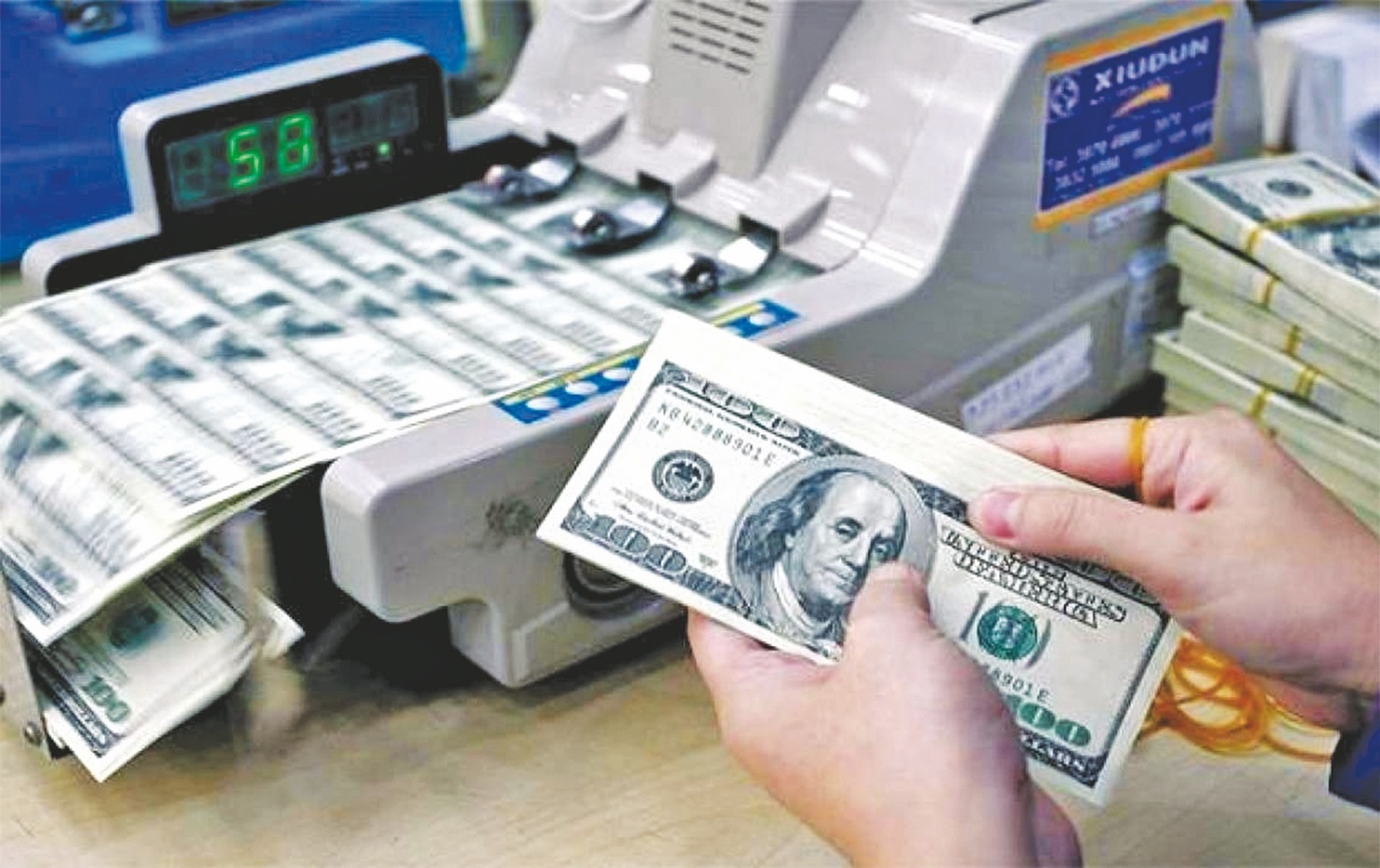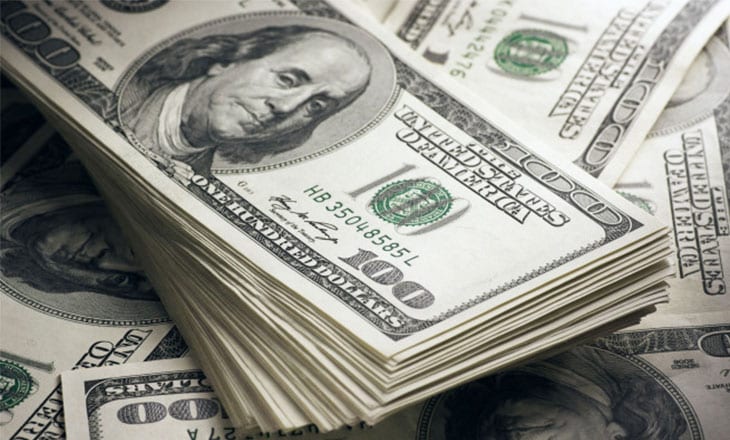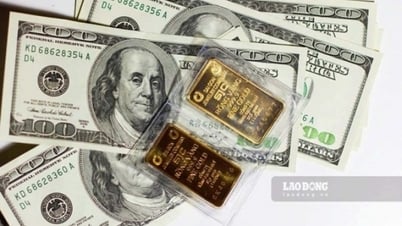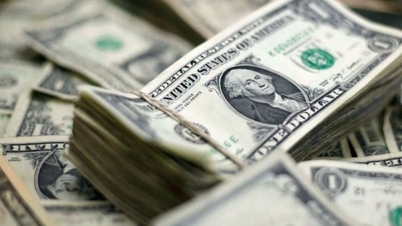USD/VND exchange rate slightly decreased
The financial market, including stocks, gold and foreign currencies, is all fluctuating strongly. In the foreign exchange market, the USD is falling quite rapidly domestically. Right from the beginning of the session on May 18, many banks adjusted the USD/VND exchange rate down.
Joint Stock Commercial Bank for Foreign Trade of Vietnam ( Vietcombank ) listed the USD/VND exchange rate at: 23,240 VND/USD - 23,610 VND/USD, down 15 VND/USD in both buying and selling compared to the end of yesterday.
At the Joint Stock Commercial Bank for Investment and Development of Vietnam ( BIDV ), the USD/VND exchange rate is traded at: 23,275 VND/USD - 23,575 VND/USD, down 25 VND/USD. The Vietnam Joint Stock Commercial Bank for Industry and Trade (VietinBank) trades USD at: 23,248 VND/USD - 23,588 VND/USD, down 77 VND/USD.
At joint stock commercial banks, the US dollar was also adjusted down quite deeply.

Although the USD reached a 7-week peak in Asia, in the domestic market, the USD/VND exchange rate decreased slightly. Illustrative photo
Vietnam Export Import Commercial Joint Stock Bank (Eximbank) exchanged USD at: 23,280 VND/USD - 23,580 VND/USD, down 20 VND/USD. At Vietnam Technological and Commercial Joint Stock Bank ( Techcombank ), the exchange rate was listed at: 23,265 - 23,605, down 25 VND/USD.
It can be seen that in the domestic market, the US dollar is maintaining a downward trend despite the greenback's fluctuations in the world.
US dollar hits 7-week high in Asia
The dollar rose to a seven-week high in Asian trading on Thursday morning, boosted by optimism about a deal to extend the debt ceiling and prevent a US default, and amid a wave of solid economic data suggesting a rate cut from the Federal Reserve could come later rather than sooner.
The dollar index, which measures the greenback against six major currencies, rose to 103.12, its highest since late March. It was up 0.3% at 102.85.
Meanwhile, the euro fell to a six-week low against the dollar at $1.0811.
“We are seeing a number of factors driving the dollar today,” said Helen Given, a foreign exchange trader at Monex USA in Washington. “Progress in debt ceiling talks, stronger-than-expected economic data from the US and hawkish comments from some Fed officials are all providing strength to the dollar.”
President Joe Biden and top U.S. Republican congressman Kevin McCarthy on Wednesday stressed their determination to reach a deal soon to raise the federal government's $31.4 trillion debt ceiling and avoid an economically catastrophic default.
After a months-long stalemate, the two political leaders have agreed to negotiate a direct deal that would need to be approved by both houses of Congress before the federal government runs out of money to pay its bills, as soon as June 1.
“Debt ceiling talks seem to be supporting the dollar regardless of how they play out,” said Joe Manimbo, senior market analyst at Convera in Washington.
“On the one hand, the continued deadlock tends to boost the safe-haven dollar. On the other hand, any constructive tone in the talks could add to the dollar’s renewed popularity,” Joe Manimbo said optimistically.
Meanwhile, US data has been generally positive, despite some economic slowdowns, supporting the view that interest rates will remain higher for longer.
Data on Wednesday showed U.S. single-family homebuilding increased in April, although the previous month's data was revised significantly lower.

The US dollar is rising strongly on the world market despite concerns about the US debt ceiling. Illustrative photo
Single-family home starts, which account for the bulk of housing activity, rose 1.6% to a seasonally adjusted annual rate of 846,000 units last month. Data for March was revised to show single-family home starts falling to a rate of 833,000 units instead of rising to 861,000 units as previously reported.
That followed reports on Tuesday that US retail sales rose in April, albeit less than expected, with the underlying trend remaining strong.
US industrial production also rose, rising 1% last month, easily beating expectations and up slightly from March's result.
Decoding the paradox
In the context of the US dollar reaching a 7-week peak in the Asian market, the USD/VND exchange rate is still decreasing thanks to positive moves from the State Bank.
In parallel with the flexible management of open market operations, since the beginning of 2023, the State Bank has purchased a large amount of foreign currency to supplement foreign exchange reserves (over 6 billion USD).
Regarding the transactions of credit institutions purchasing foreign currency on a term basis with the State Bank, the State Bank and credit institutions have also extended these transactions with a total value of 3.99 billion USD, while credit institutions have canceled the purchase of 1.74 billion USD from the State Bank, thereby contributing to the release and circulation of a large amount of VND.
In addition, for transactions of credit institutions purchasing foreign currency on a term basis with the State Bank, the State Bank and credit institutions have also extended these transactions, thereby the State Bank does not withdraw/delay the withdrawal of VND from circulation.
The above solutions have significantly contributed to creating excess liquidity in the market, thereby stabilizing the interbank market interest rate level, supporting credit institutions to reduce deposit interest rates and reduce lending interest rates for the economy.
Source


![[Photo] More than 17,000 candidates participate in the 2025 SPT Competency Assessment Test of Hanoi National University of Education](https://vphoto.vietnam.vn/thumb/1200x675/vietnam/resource/IMAGE/2025/5/17/e538d9a1636c407cbb211b314e6303fd)


![[Photo] Prime Minister Pham Minh Chinh chairs meeting on science and technology development](https://vphoto.vietnam.vn/thumb/1200x675/vietnam/resource/IMAGE/2025/5/17/ae80dd74c384439789b12013c738a045)

![[Photo] National conference to disseminate and implement Resolution No. 66-NQ/TW and Resolution No. 68-NQ/TW of the Politburo](https://vphoto.vietnam.vn/thumb/1200x675/vietnam/resource/IMAGE/2025/5/18/adf666b9303a4213998b395b05234b6a)




























![[Photo] Readers line up to visit the photo exhibition and receive a special publication commemorating the 135th birthday of President Ho Chi Minh at Nhan Dan Newspaper](https://vphoto.vietnam.vn/thumb/1200x675/vietnam/resource/IMAGE/2025/5/17/85b3197fc6bd43e6a9ee4db15101005b)




































































Comment (0)